Many comets are blue-green in color due to Swan band radiation. This was thought to be caused by cyanogen gas many comets emit. Today we know this isn't really true. The color is due to fluorescence of carbon particles rather than the cyanogen gas itself. But comets do emit cyanogen gas. When it was announced that in 1910 we'd pass through the tail of Halley's comet and it emitted cyanogen gas, same as used in gas chambers there was panic. My grandfather worked in a theater in NYC at the time. Suddenly in January the Great Comet of 1910 appeared and most thought it Halley and they were about to die. So he and my grandmother made sugar pills in their hotel room and sold them in the theater lobby for $10 each. Admission was only 75 cents so this was a small fortune. They were guaranteed to protect you from the gas. My grandmother worked 19 hours a day making pills and they sold some $300,000 worth -- after the theater and magic act he worked for got their cut. That was about 50,000 pills all handmade by my grandmother and a couple maids they hired. They then retired to a house full of servants in Omaha. In 1913 the Easter Sunday tornado lifted their 4 story mansion off its foundation and carried it a block setting it down on another mansion. Then a third was deposited on them. They were 10 days in the mess before rescue as no one was considered alive in the area. They were the only survivors from that 2 block area. Near death, they somehow survived. My mother was 2 at the time. She was apparently the result of their celebration over selling so many pills. Anyway, they rebuilt but being underinsured it cut into their fortune. My mom only had 3 servants after that to wait on her, not 6. Oh yes, those 6 died as they were in the basement. My mom and my grandparents were on the stairs between the third and second floor heading for the basement but luckily didn't make it. The basement was exposed when the mansion flew away and yet another house crushed those in it. My mom's luxury life suddenly ended with the '29 crash. My grandfather was sent back into the workforce leaving them with no servants and barely a roof over their head. Easy come easy go. Much like comets.
The comet is much larger in this photo than you'd have seen in a scope or binoculars. This was taken July 11, 2007. The photo has been reduced and cropped. Image scale is 2" of arc per pixel, half my normal scale. The nucleus of the comet is hidden in the bright spot in the center and is only a mile or so across. Just a microscopic dot at this scale.
The stars are lines because I had the mount tracking the comet rather than the stars. It is moving rapidly against the stars and rather close to us as well. The color frames show up as the stars are colored red green and blue. I used two of each after I took 20 luminosity images. Each is a one minute exposure. The gaps in the white trails are due to the time it takes to download a frame to the computer -- about 10 seconds. The bigger gap is because I took the shots in two 10 minute groups and wasn't around to restart it immediately. Then I had to set up for color making for other gaps in the stars. The comet is moving southwest so the stars appear to move up and to the right, northeast.
Image is at 2" per pixel.
14" LX200R @ f/10, L=20x1', RGB=2x1', STL-11000XM, Paramount ME | 
C2006VZ13_20X1RGB2X1_50%.jpg
| 34 Minutes in the life of Comet C/2009 R1 McNaught. This was taken in a very bright dawn sky that got over three times brighter during the 34 minutes it was taken. Some frames were lost to clouds. A couple show space junk flying by as well. Due to the rapidly brightening skies it was very difficult to process this to hold the tail detail as the sun was trying to drown it out. As a result the head of the comet seems to grow in fits and starts over the 34 minutes. I processed for the tail and sky background and ignored the head for the most part. It took three days of trial and error just to get it to this point. With cloud haze varying with every exposure and the dawn sky giving a background count of 3000 to 10,000 (normal for 1 minute is 250) this was a processing nightmare.
Note that the comet has both a short, fuzzy, stubby dust tail pointing a bit down and to the right and a much longer gas tail pointing up and to the right. The dust tail does point away from the comet's motion but the gas tail points away from the sun. The motion of the stars shows this quite clearly for the dust tail. The gas tail changes quite a bit over the 32 minutes the movie covers. The very end of the gas tail passes over the galaxy UGC 01997 which is about 270 million light years beyond the comet.
Unfortunately, the comet, for me, is moving deeper into the dawn sky so there's no second chance on this one. Besides there's been a near constant mist falling since I took this movie. In fact a very light mist was falling while I imaged this. It was semi clear in the area of the comet. I spent 40 minutes holding an umbrella over the scope while this was taken. What we won't do for this hobby. Another new moon clouded out. I'm falling further behind in my Arp galaxy imaging.
The comet has an orbital eccentricity of 1.0003. If correct that would mean it is on a hyperbolic orbit and will never return. It was about .72 AU (67 million miles) from the sun and 1.16 AU (108 million miles) from the earth when I took this movie. It will be closest to the sun on July 2 at about 0.40 AU from the sun. Unfortunately it will be lost in the sun's glare at this time. It's closest approach to the earth is June 15, 2010 at 1.14 AU. So this was taken at nearly its closest approach to us.
Movie is about 4 meg so will take a while to load. Once loaded it will run more smoothly.
14" LX200R @ f/10, 28 one minute exposures binned 3x3, STL-11000XM, Paramount ME | 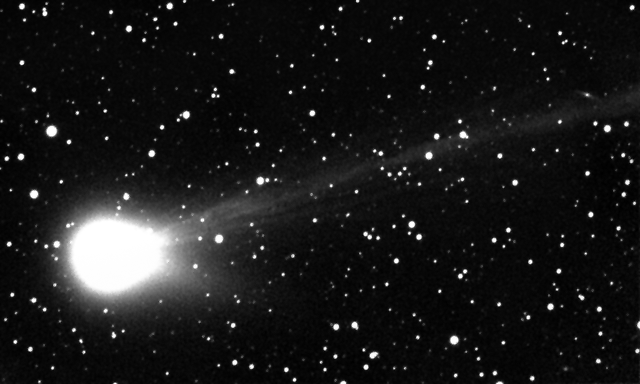
C2009R1a.gif
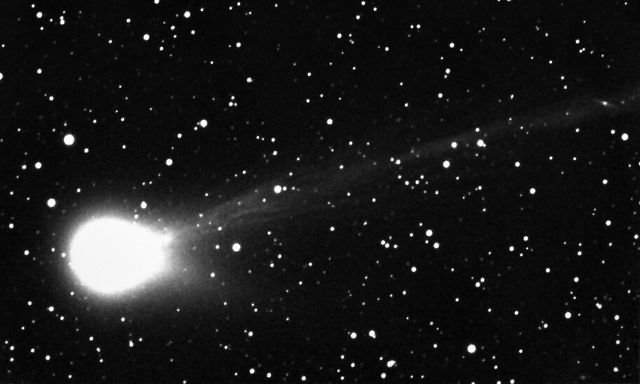
CA10.jpg
| C/2011 L4 (PANSTARRS) was a nice comet in the second week of March. Unfortunately, my lousy weather and neighbor's trees prevented me from imaging it until June 13, 2014 when it was far to the north. At just over 2 AU from both the Earth and the Sun I wasn't expecting much. But its anti-tail running almost due north was still there and is stronger and far more well defined than the dust tail to the southeast (upper right). I see no sign of a gas tail nor the typical green color from comets closer to the sun to get enough UV light to create it. It's rather white with a reddish tinge. I enhanced the comet's color way too far trying to find any color in it.
Putting together this composite was "fun". I now remember why I don't do this very often! The color data is made from three 5 minute frames each color taken tracking the comet. The luminance was made from 15 5 minute frames also taken tracking the comet. These are all unguided letting the Paramount and The Sky track the comet using the orbital elements of the comet to govern tracking using offsets on both axes added to the standard sidereal rate. Then two nights later when it was again clear I imaged exactly the same starfield this time tracking on the stars using 3 5 minute color frames per color and 3 10 minute luminance frames. Then the comet's color image (less the stars) was placed into the starfield using the comet's position at the start of the very first luminance frame. To set that I used that first frame as a layer which was then removed so it should be accurate to one second of arc which is my pixel size.
The reason for only 5 minute frames for the comet is that it was outside the dense portion of my T Point map that allows accurate tracking without guiding. I found it was still reliable for 5 minute frames so used those. The starfield luminance frames were 10 minutes each and guided. The reason for only three 5 minute frames of each color is dawn was fast approaching and I didn't have time for my usual 2 ten minute frames. My dark skies are very limited at this time of the year and I had to wait for it to clear eating up much of that time. This is why the starfield had to be done another night as well. Just no time for both the same night.
Removing the stars when there are only 3 frames to work with in the color data was an interesting exercise. Lots of trial and error in CCD-Stack finally found the right parameters. I used a Poisson rejection routine with a sigma of .2 then combined using the minimum mode. That completely removed the stars from the luminance and left only one small smudge to clone out of the color data. That was caused by the brightest star in the field (lower right).
I wish the weather had allowed me to try earlier when the anti-tail was much stronger. Also, I needed a wider field of view as it stretched some 6 or more degrees at one time. It went out of my very limited field. I should have rotated the camera to put it along the long axis I suppose. I'd hoped to catch more of the dust tail but that is just a blob on the southeastern side right now.
In any case, it is surprisingly bright even 3 months after it came by and worth a look. This is one time I wish I had a OSC camera. Simplifies color with a moving target like this. Also, a shorter focal length than the 14" LX200R offers would help as well!
The image is oriented with south at the top, the opposite of my normal orientation. It seemed more "natural" that way, looking "wrong" when rotated to my normal orientation. There appears to be some weak IFN in the image, especially to the lower left.
14" LX200R @ f/10, see text for exposure data, STL-11000XM, Paramount ME | 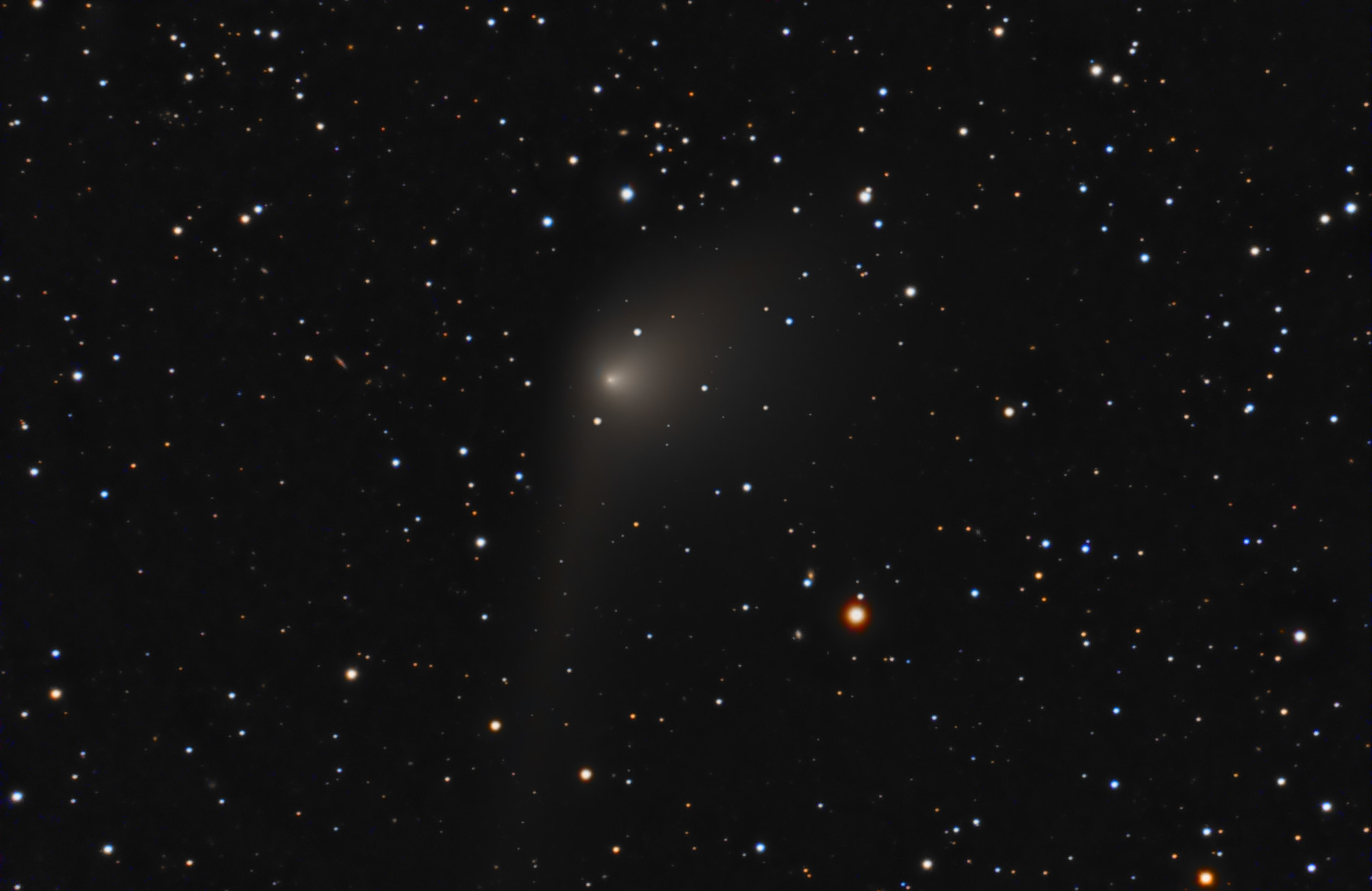
C2011L4COMBINE.JPG
| Comet C/2012 K1 (PANSTARRS) was putting on a pretty good show and was visible all night (though those are getting awfully short for me now) when this was taken June 4, 2014. At the time of the image, the comet was 2.069 AU from the sun and 1.472 AU from the earth. I took this data on May 4 about 8 hours UT when a hole opened in the clouds. I had less than an hour before dawn so didn't get as much data as I'd have liked. The comet was moving about 3" of arc per minute. I set the mount to track the comet which elongated the stars a bit. I started to "fix" them but it was slow going and I gave up so some are fixed and others show the motion. I shouldn't have started "fixing them".
With only one minute frames my read noise is rather high limiting how faint I could go. Also, I only had time to collect 20 one minute luminance frames. These were taken binned 2x2. Due to noise issues, I reduced the image to the equivalent of 3x3 binning (1.5" per pixel). Seeing the noise in the luminance I took the color data binned 3x3 using 5 two minute frames for each color. This caused the star colors to trail twice that of the luminance. I then used the simple trick of making a second layer, moving the top layer halfway in the direction of the star trails and combining using the darken mode. Quick and dirty way to match the star trails to that of the luminance frame. What error remained was covered by blurring the color data by a pixel. In the 50 minutes before dawn, this was all the data I had time to collect.
Still, the image came out better than I expected. The ion tail I thought I saw in my dawn hampered earlier image went straight down. In this image, there was an obvious short ion trail going to the southeast. While the comet has moved some in the sky I doubt the tail has rotated that much so suspect my hint of an ion trail in the earlier image was just noise. Though I don't see the curve in the dust trail I did in the first image and I'm sure that was real. Oddly the ion trail doesn't seem to point right back at the nucleus but at a point a bit behind it.
There's an obvious galaxy in the lower right corner. It is SDSS J131507.60+492030.1 (AKA ASK 286584.0, 2MASX J13150752+4920302, MAPS-NGP O_173_0046263) and has a look back distance of 750 million light-years. It appears to be an edge on spiral. Near the left edge below center is SDSS J131747.72+492651.2 at 1.72 billion light-years, another disk galaxy seen somewhat edge on. Between the end of the ion tail and the dust tail is SDSS J131634.18+492159.2, a face on spiral about 900 million light-years distant. There are others but I'll stop here.
14" LX200R @ f/10, L=20x1'x2 RGB=5x2'x3, STL-11000XM, Paramount ME Related Designations for C2012K1C2012K1, | 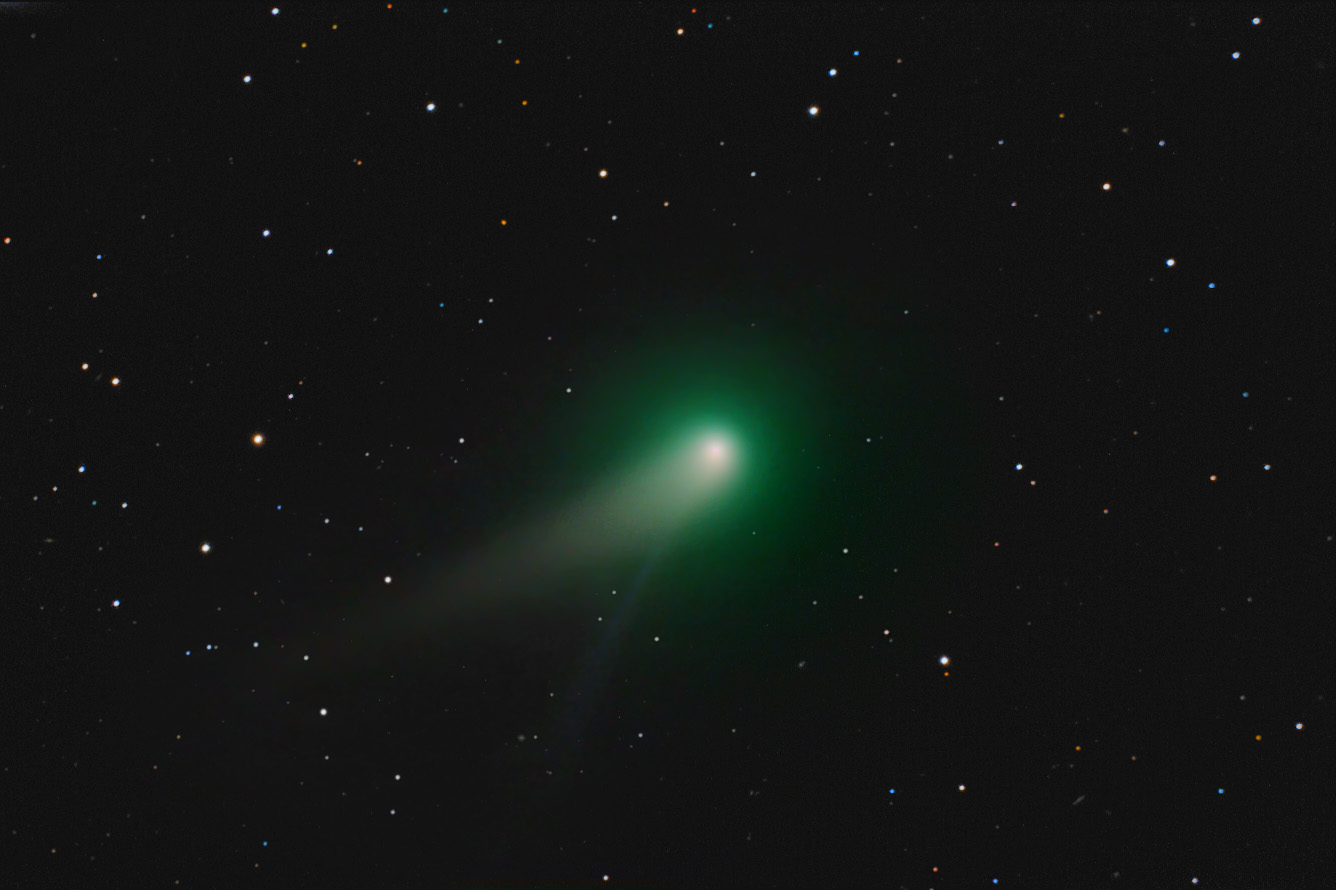
C2012K1L20X1X2RGB5X2X3.JPG
| On the morning of December 11, 2013 I finally had sort of clear skies to take data on the comet. As it was a nightmare to process due to the clouds so I kept putting it off. Now I wish I hadn't as I seem to have caught it ejecting a blob of material from the core. At least the images show a odd linear feature below and a bit west of the brightest part of the coma. It is rather red compared to the rest of the comet and has a dark area beyond it. Since the comet points toward the sun, I don't see how the darker area could be a shadow. Still, it is real. Though when I first processed the image I wondered if it was some background object but then I assembled the luminance data into a movie and the feature moves with the comet though seems to be moving very slightly away and behind the core. Dawn prevented a longer movie that might have shown this. I'd hoped to get detail of gas clouds moving down the tail. The tail had only very weak, indistinct detail. Still, if you look closely about halfway up the tail some motion can be detected. Set your viewer to repeat as the 30 minutes is compressed to 3 seconds of time for a time speed up of 600x. The color image was taken and is posted at 1.5" per pixel. Seeing this low didn't allow for any higher resolution.
Color image:
14" LX200R @ f/10, L=10x1'x3 RGB=7x1'x3, STL-11000XM, Paramount ME
The L frames used are every third frame used for the movie. This was needed to give time for enough motion between frames so stars moved enough they could be eliminated from the image of the comet when the frames were aligned on the comet's core. This gave a star free comet image to be pasted back into the starfield after the moving comet had been cloned out. The color frames were taken red, green, blue with the cycle repeated 7 times (all the oncoming dawn allowed). This moved each frame sufficiently that the same process could be used to create the color data used to make the final image. None of the color frames were used in the movie however. The movie used all 30 of the luminance frames, including two in which some space debris put in an appearance. I could have cloned them out but decided to leave them in as my cloning usually makes thing worse. | Video: https://images.mantrapskies.com//catalog/OTHER/C2013R1LOVEJOY/C2013CONTRAST.wmv 
C2013R1L10X1RGB7X1R1.JPG
| I'd wanted to retake this one this fall with my new filters that don't have the halo problem around stars my old filters had. But the weather conspired against me. I settled for reprocessing the old data. I think this is much better than before but you'll have to pretend the halos aren't there.
When I first got into astronomy and started building my first telescope it was announced that the 200" had finally imaged the long sought super nova remnant known as Cas A. The image was hardly exciting. I found the image I remember as figure three in this 1953 paper:
http://articles.adsabs.harvard.edu/cgi-bin/nph-iarticle_query?1954ApJ...119..206B&data_type=PDF_HIGH&whole_paper=YES&type=PRINTER&filetype=.pdf I've had reports this link sometimes fails. If so start here: http://simbad.u-strasbg.fr/simbad/sim-ref?bibcode=1954ApJ...119..206B
It was finally found when crude radio interferometry gave a better location but the image sure wasn't much. I certainly never expected I'd ever be imaging what was at the very limit of the 200" scopes ability in 1953. It cost millions of dollars and the scope I was building back then ended up costing me about $35 for a 6" f/12 on a pipe mount using homemade eyepieces (Coke bottle bottoms worked better I'm sure).
For those who say I never put much time into an image, your right but at least this one used 4 hours 50 minutes of data rather than the 1:40 I normally use. I wanted 6 hours of L data and 1 hour of each color but never had enough clear nights to even start it in which transparency would hold for the time needed.
Image was cropped to reduce bandwidth and some of those nasty stars but not reduced. This is still at 1" per pixel, my normal image scale.
14" LX200R @ f/10, L=14x10' RGB=5x10'x3, STL-11000XM, Paramount ME Related Designations for CAS ACassiopeia A, 3C 461, 3C 461 ID, 4C +58.40, 87GB[BWE91] 2321+5832, 8C 2321+585, NRAO 0711, 1RXS J232325.4+584838, 2PBC J2323.3+5849, PBC J2323.3+5849, SAXWFC J2323.5+5848.1, 4U 2321+58, 1H 2321+585, 1ES 2321+585, SWIFT J2323.3+5849, [VE75] CL 2321+58, [KRL2007] 402, CAS A, SNR G111.7-02.1, TeV J2323+588, | 
CAS_A_LUM-AV14X10RGB5X10X3R1-1200.jpg
| Cas 1 (not to be confused with Cas A a supernova remnant) is a heavily obscured irregular dwarf galaxy in Cassiopeia about 8 degrees north of the Heart and Soul Nebulae. It is considered part of the Maffei group of obscured galaxies. The distance to obscured galaxies is hard to determine. There was only one estimate at NED but its determination is purely by judging the size of a single HII region. Thus it is highly suspect. It gives a distance of 16 million light-years which is likely too far. The generally accepted distance to the Maffei group is more like 6 to 10 million light-years. In any case, it is nearby, just nearly invisible as it lies behind the gunk of the disk of our galaxy. Its color is likely reddened by the dust. Most dwarf irregular galaxies are quite blue. Cas 1 is likely no exception if we could see it without the dust.
This one is so dim I spent 3 times my usual time for the luminance channel and twice normal for the color channels. It didn't seem to help much.
14" LX200R @ f/10, L=12x10' RGB=4x10', STL-11000XM, Paramount ME Related Designations for CAS1Cas 1, IRAS 02019+6845, ZOAG G129.56+07.09, ZOAG G129.57+07.11, LEDA 100169, NVSS J020558+685955, [W95] 1, [KK98] 019, [KK98] 020202.4+684557, CAS1, | 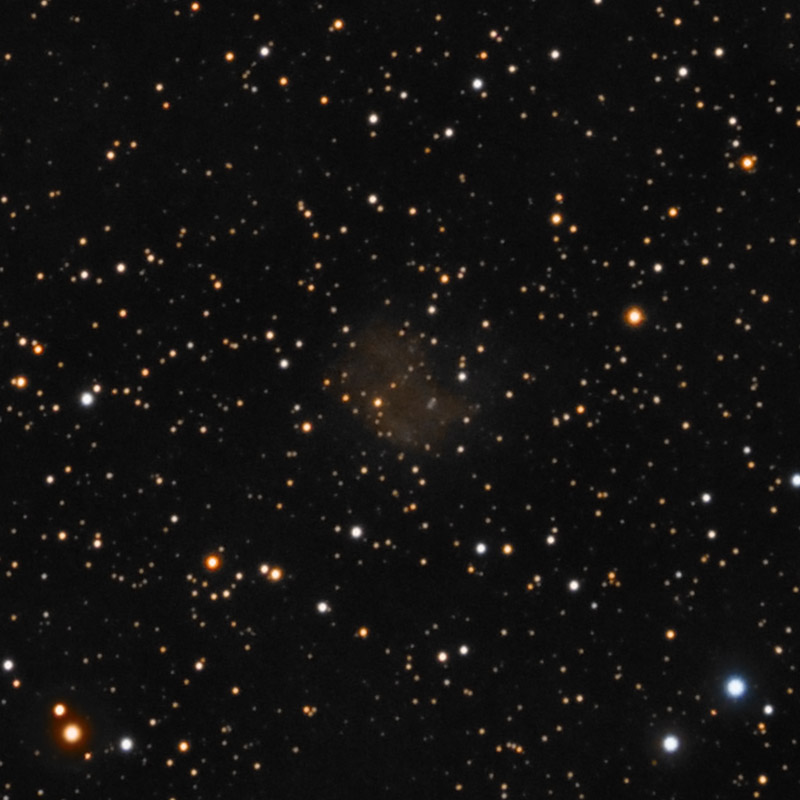
CAS1LUM12X10RGB4X10R-CROP125.JPG
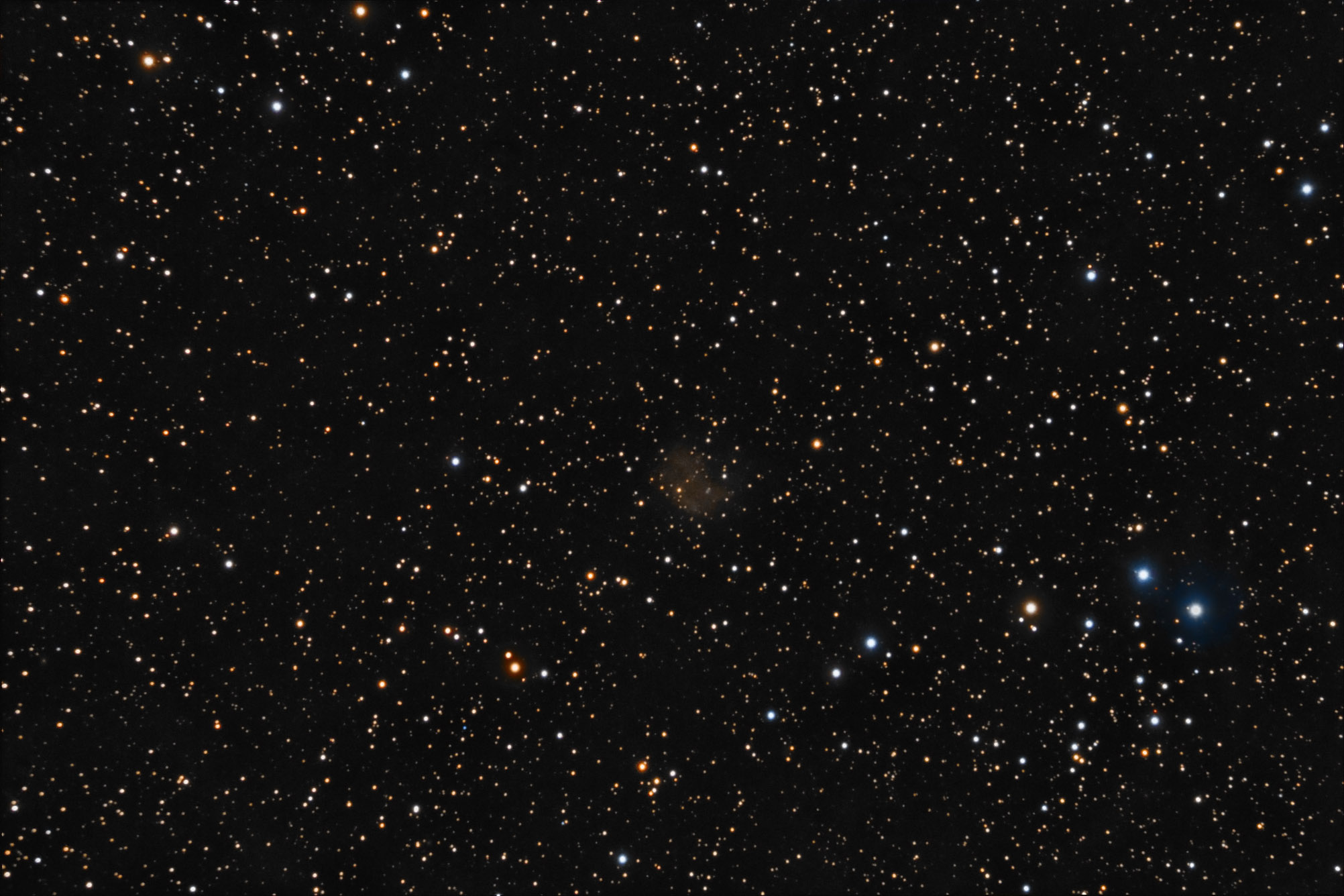
CAS1LUM12X10RGB4X10R.JPG
| This nebula, mostly emission (red) with some reflection characteristics as well (blue) is located in Cepheus. It is part of the Cepheus B molecular cloud. The illuminating stars are considered to be HD 217086 at the top of my image, an O7 star and HD 217061 above center, a B1 star (very slightly smaller and cooler). IR images show a tremendous amount of star formation going on in the cloud (darker portions of my image). These are thought to be triggered by HD 217086. It is outside the cloud itself. Radiation from the star is thought to drive a compression wave into the cloud triggering star formation in the interior while blowing away the cloud's outer layers. Chandra/Spitzer observation in X-ray and IR light show this is happening. The region is thought to be about 2400 light years from us.
This is a reshoot of this object. I did it very poorly early in my digital career. It was time for a better effort. Still not what I wanted. I wanted a lot more color data but after two months of something preventing it I apparently gave up. Maybe I can get the needed data later this fall. For now, I put together what I had. I used the RGB data to try and bring out the reflection parts of the nebula and H alpha data to bring out the ionized hydrogen in the area (red). With too little RGB the hydrogen is dominating more than I wanted. Still, the reflection regions are sort of there.
14" LX200R @ f/10, L=4x10'+2x30'Ha (Ha blend at 40%), R=2x10'+40% Ha (to allow reflection nebula to show), G=2x10' and B=2x10'+10% Ha, STL-11000XM, Paramount ME | 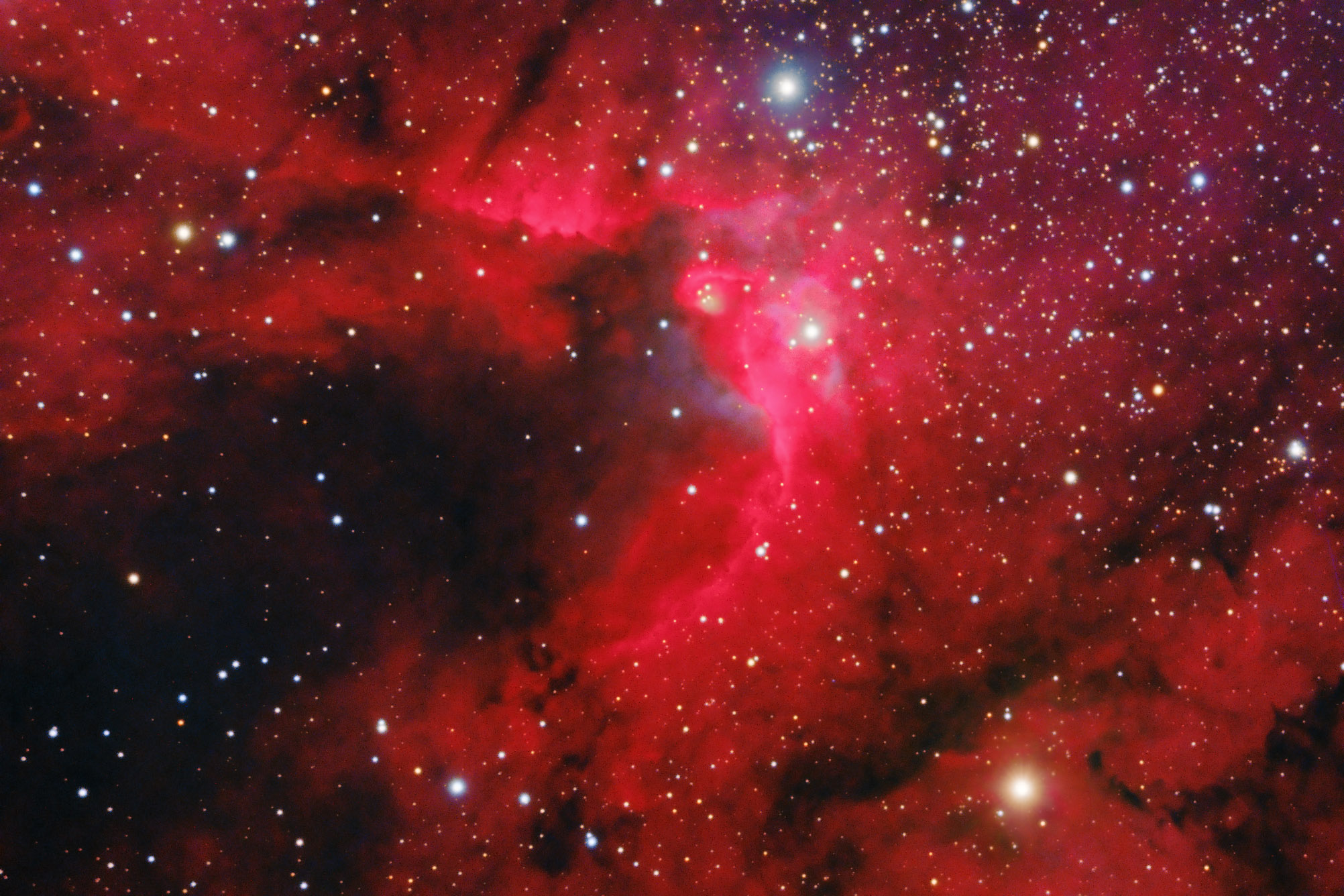
SH2-155CAVE_L4X10HA2X30RGB2X10R1.JPG
| Cederblad 90 isn't all that well known. It is part of the Seagull Nebula also known as the Gum 1 complex or IC 2177. The seagull flies sideways through space with his wings up and down and his head to the west. The whole complex would require many dozen images at my image scale to cover so I've been picking it apart. The head last year and now the very end of the lower wing this year, CED 90. It is a combination reflection and emission nebula. The reflection part is blue while the emission part is pink. They mix to give it a rather odd color at times. Much of its color data was taken through a severe haze so the color balance is a guess at best. I need to try again under better conditions. Information on this guy is skimpy. I couldn't find a good distance estimate. I'm going to guess about 1800 light years. No H-alpha data was used. It likely would have helped the color if I had.
14" LX200R @ f/10, L=6x10, RGB=2x10'x3, STL-11000XM, Paramount ME Related Designations for CED90CED90, | 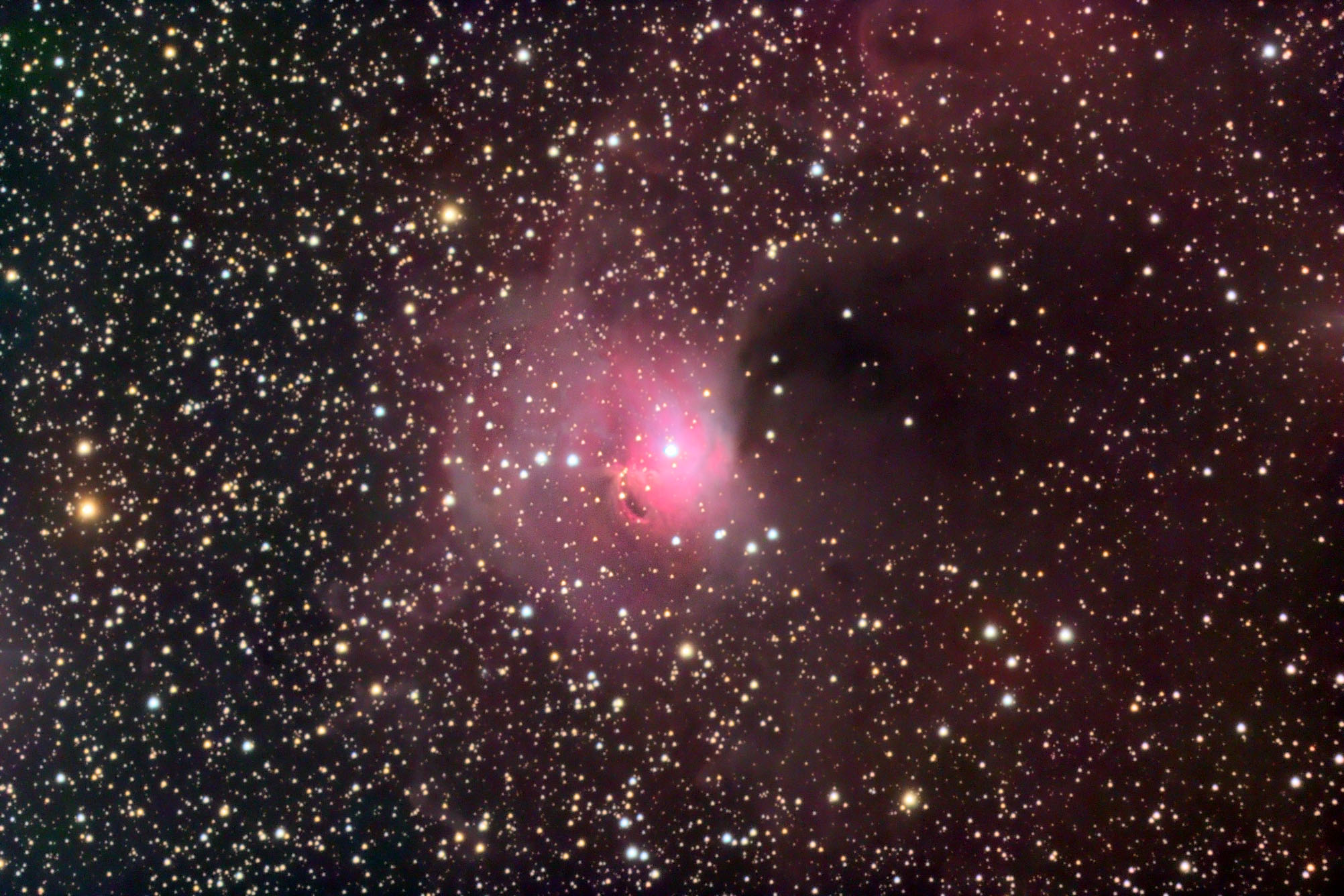
CED90_L6X10RGV2X10X3.jpg
| This Smiley Face or Happy Face is the result of gravitational lensing of distant galaxies beyond the lensing galaxies. NED gives it the name Cheshire Cat if you are looking it up. An alternate name is Cassowary 02L1. A bird and its hunter. Though I suspect most house cats would end up very dead if they took on a Cassowary. When I was in Australia we were cautioned not to get near one as they were "The most dangerous bird in the world" or something like that. True or not we stayed very clear of the two we saw. They are quite rare so seeing one isn't common. Habitat loss is the problem.
Back to astronomy. NED puts it about 4.5 billion light-years away with a redshift of 0.426. Is that the distance to the lensing galaxies or the lensed galaxies? I think that is the distance to the lensing galaxies. NED has an entry centered on part of the blue arc, CASSOWARY 02G with a distance of 7.65 billion light-years with a redshift of 0.966. NED points two other at 11.37 billion light-years. So the cat is made up of many unrelated galaxies that have the proper geometry when seen from earth to make a smiling face. It is the lens that brightens these very distant galaxies sufficiently that I can see them. I doubt any would be visible in my 14" scope without the foreground lensing galaxies. The CASSOWARY name is an acronym for CAmbridge Sloan Survey Of Wide ARcs in the skY. Someone had to really stretch for that one! Anyone know why the Australian tie?
Using the diameters of the two "eyes" at NED and a distance of 4.5 billion light-years I get a size for these two galaxies of about 110,000 to 120,000 light-years. Not as big as I expected for how bright they are. Their brightness isn't enhanced by the gravitational lens they create for the background galaxies. NED says they are magnitude 20.2 and 20.5 left to right. Normally I find galaxies at this distance to be at least a magnitude dimmer, often 2 magnitudes fainter. Though ASK 186534.0 is magnitude 18.3, 2.18 billion light-years distant and 145,000 light-years across making the two lensing galaxies somewhat smaller and dimmer by comparison.
I've had this one on my to-do list since February 2015 when it was first announced. The complex passes less than 2 degrees of my zenith so I expected it easy to get good enough seeing for long enough that I could catch it. I figured on a minimum of 2 hours of luminance, three times my typical exposure time. But seeing has never cooperated. Finally this March the night met my specifications and I started in with near 0.5" resolution for one frame. After 4 (each 10 minutes) seeing had deteriorated so much I had to stop. Since color data can survive such seeing I started in on that and got one round of 2 frames each before seeing then said no way and besides clouds moved in. I had to throw out one green frame as it was too cloud hit to be used. I had several more clear nights but seeing just wasn't good enough. Ditto for April. Now it is too far west and low for the seeing I need for this super tough object. Even though I had no more data than I use for most of my imaging I went ahead and processed it. The better than normal transparency for the first 3 frames allowed me to get something, just not what I wanted. It doesn't compare to Josh Smith's fantastic image using over 32 hours of luminance. https://www.astrobin.com/286097/0/ Adjusting for aperture that's 5 hours at 14 inches or 7.5 times the photons I was able to grab. Josh send me your seeing and clear skies. I was surprised I got as much as I did though the resolution was poor due to the low signal to noise ratio and deteriorating seeing. After I picked up the smile and the arc on the west I noticed the eastern side of the arc was missing. But it is pretty well lost in Josh's image as well. If I get needed skys next year I'll try and add more photons. In the meantime Josh's image is a good example that small aperture can do as well as larger if you put in the additional time to catch enough photons.
Since the image didn't do what I wanted I did annotate everything with redshift data at NED. Also, here's the link to the Hubble version https://www.nasa.gov/content/hubble-sees-a-smiling-lens . It's a bit better than mine but is it billions of dollars better?
14" LX200R @ f/10, L=4x10' RB=2x10' G=1x10', STL-11000XM, Paramount ME
| 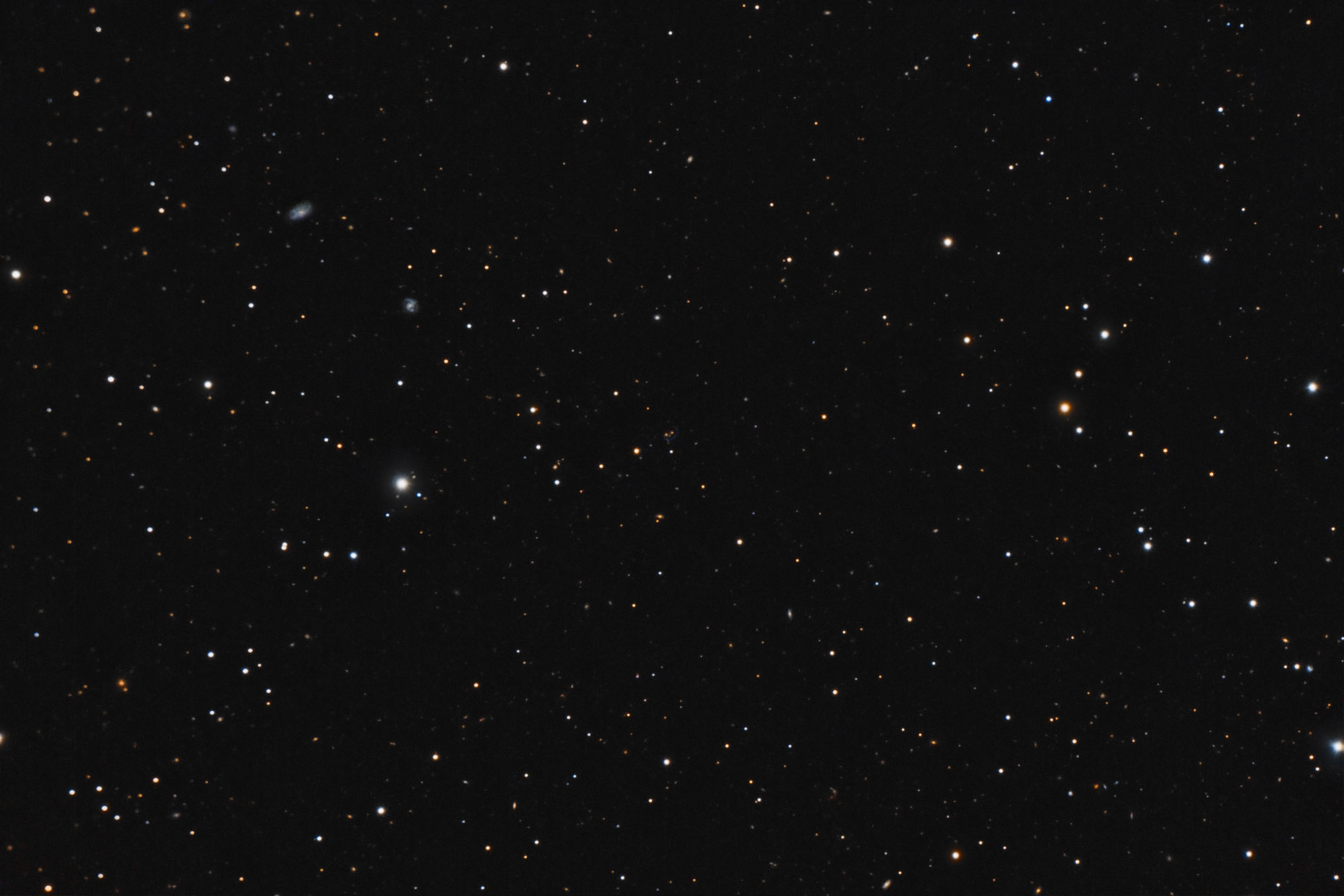
HAPPYFACEL4X10RB2X10G1X10.JPG
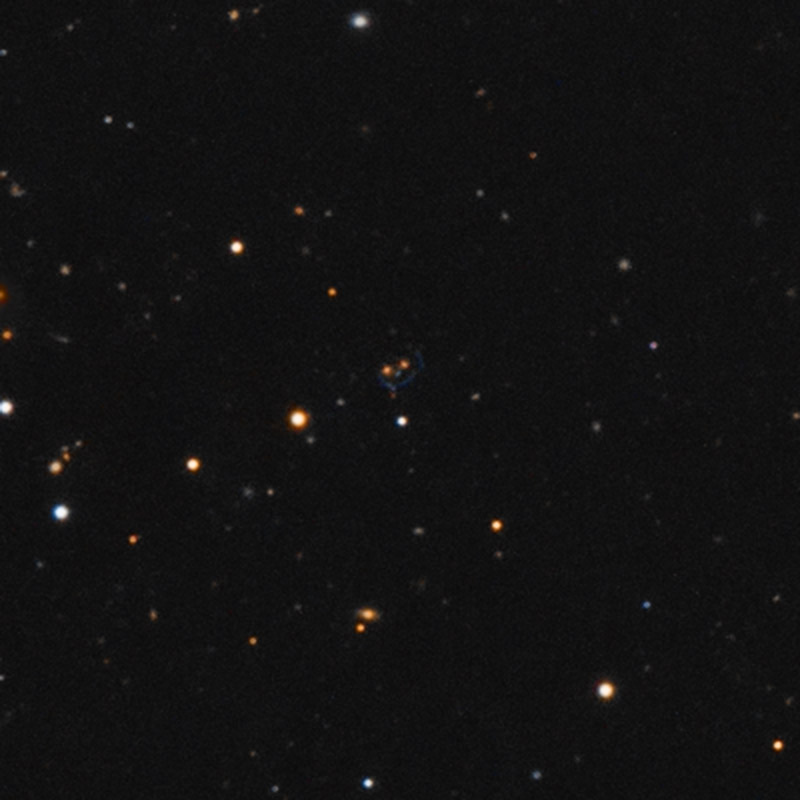
HAPPYFACEL4X10RB2X10G1X10CROP200.JPG
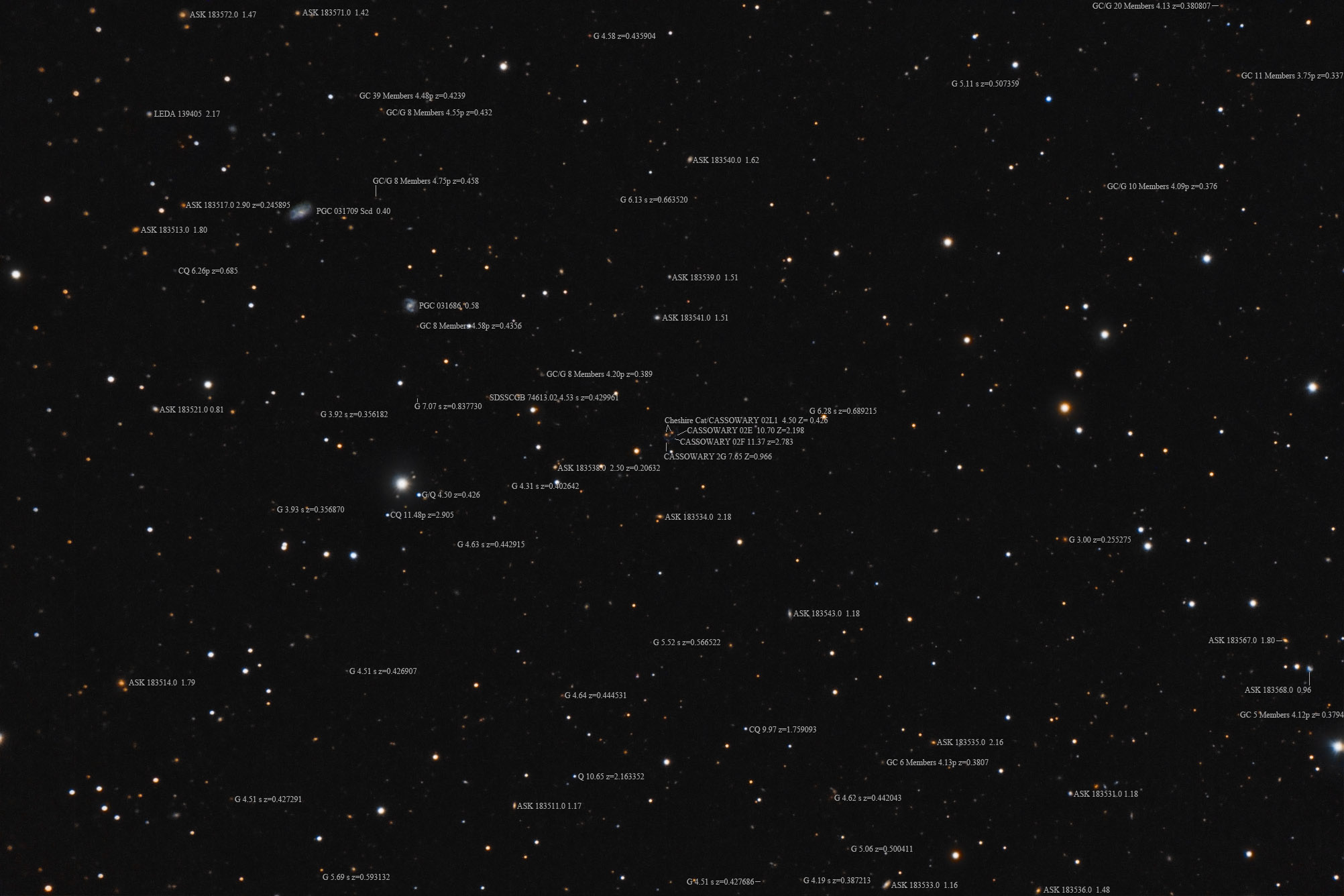
HAPPYFACEL4X10RB2X10G1X10ID.JPG
| 












